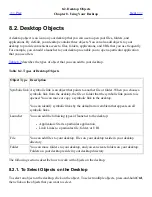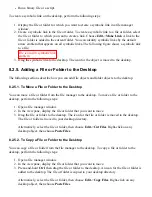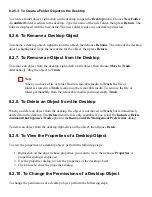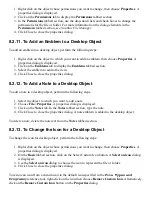
You can also select an area on the desktop to select all objects within that area. Click-and-hold on the
desktop, then drag over the area that contains the objects that you want to select. When you click-and-
hold then drag, a rectangle appears to mark the area that you select.
To select multiple areas, press-and-hold Ctrl, then drag over the areas that you want to select.
8.2.2. To Open an Object from the Desktop
To open an object from the desktop, double-click on the object. Alternatively, right-click on the
object, then choose Open. When you open an object, the default action for the object executes. For
example, if the object is a text file, the text file opens in a file manager window. The default actions
for file types are specified in the
File Types and Programs
preference tool.
To execute an action other than the default action for an object, right-click on the object, then choose
Open With. Choose an action from the Open With submenu.
The items in the Open With submenu correspond to the contents of the following parts of the
File
Types and Programs
preference tool:
●
Default action drop-down list in the Edit file type dialog
●
Viewer Component drop-down list in the Edit file type dialog
You can set your preferences in a file manager window so that you click once on a file to execute the
default action.
8.2.3. To Add a Launcher to the Desktop
A desktop launcher can start an application or link to a particular file, folder, FTP site, or URI.
To add a launcher to your desktop, perform the following steps:
1. Right-click on the desktop, then choose New Launcher. A Create Launcher dialog is
displayed.
2. For information on how to enter the properties of the launcher in the Create Launcher dialog,
see Working With Panels. The command that you enter for the launcher is the command that
is executed when you use the desktop object.
8.2.4. To Add a Symbolic Link to the Desktop
You can create symbolic links on your desktop to perform the following actions:
●
Open a particular file in a particular application.
●
Open a particular folder in a file manager window.
Summary of Contents for 2.4
Page 9: ... Prev Home Next 1 3 Using Windows Up 2 1 Introducing Desktop Environment Components ...
Page 15: ...5 7 Customizing Your Menus Up 6 1 Windows and Workspaces ...
Page 40: ... Prev Home Next 2 4 Windows Up 2 6 Nautilus File Manager ...
Page 76: ... Prev Home Next 4 7 Menus Up Chapter 5 Working With Menus ...
Page 84: ... Prev Home Next 5 3 Applications Menu Up 5 5 Main Menu ...
Page 86: ...5 4 Actions Menu Up 5 6 Menu Bar ...
Page 99: ... Prev Home Next 6 2 Types of Window Up 6 4 Manipulating Windows ...
Page 149: ...Chapter 8 Using Your Desktop Up 8 2 Desktop Objects ...
Page 157: ... Prev Home Next 8 2 Desktop Objects Up 8 4 Using the Desktop Menu ...
















































